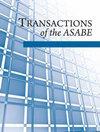风喷淋机在现代苹果园系统中的顺风喷淋漂移评价
IF 1.4
4区 农林科学
Q3 AGRICULTURAL ENGINEERING
引用次数: 7
摘要
在距离果园边缘183米(600英尺)的下风处,对喷风喷雾器的漂移潜力进行了评估。在一个中央领导苹果园的休眠期和满冠期喷施。在全冠期较大的漂移可能是由于较高的风速和较低的湿度。绳状和人工树叶取样器的收集效率比聚酯薄膜卡片高。果园农药喷洒风险评估目前是基于最坏情况(休眠期)下的喷雾漂移估计。然而,大多数喷雾应用是在非休眠冠层生长阶段进行的。这种高估导致有害生物管理活动的限制性业务条例。因此,现场数据被生成并研究了一个机制模型,该模型将预测在果树果园中使用空气喷射喷雾的喷雾漂移。在一个中央领导栽培的苹果园进行了休眠期和满冠期的喷雾试验。轴流式送风喷雾器从果园的下风边缘喷洒荧光示踪剂在第三排,四次为一次运行。在作物生长的两个阶段,每个阶段共进行了20次喷施,即17次喷施和3次空白。使用聚酯薄膜卡、人工叶片(AF)和水平串(HS)来量化下风183米(600英尺)处的漂流喷雾沉积。果园内喷施行上风向3 m卡样上沉积量为休止期施量(AD)的21.94%±4.63%(平均值±标准差),满冠期施量(AD)为16.02%±2.86%。在休眠和满冠期,下风和喷淋行附近(-3 m)的AD分别为17.92%±2.70%和7.15%±1.78%。果园边缘的喷雾漂移显著减小,休眠期为3.18%±1.30% AD,满冠期为2.30%±1.16% AD。在果园下风183 m (600 ft)处,喷雾漂移非常低,在休眠期沉积0.002%±0.003% AD,在满冠期沉积0.003%±0.004% AD。在常见采样点收集的沉积数据显示,HS和AF采样器比卡片采样器收集到更多的漂流喷雾(p < 0.05)。在两个生长阶段(休养期R2= 0.80,满冠期R2= 0.86),下风风速与喷雾漂移均有较强的线性关系,而温度和湿度的影响不能直接从所收集的数据中观察到。关键词:风喷淋,沉积物采样器,休眠和全冠层,漂移,现代果园系统本文章由计算机程序翻译,如有差异,请以英文原文为准。
Downwind Spray Drift Assessment for Airblast Sprayer Applications in a Modern Apple Orchard System
HighlightsAirblast sprayer drift potential was evaluated up to 183 m (600 ft) downwind from an orchard edge.A central leader apple orchard was sprayed at dormant and full canopy stage.Higher drift at full canopy stage was likely due to higher wind speeds and lower humidity.String and artificial foliage samplers had higher collection efficiencies than Mylar cards.Abstract. Risk assessment of orchard pesticide spraying is currently based on spray drift estimation using a worst-case scenario (dormant stage). However, most spray applications are conducted during non-dormant canopy growth stages. Such overestimation leads to restrictive operational regulations in pest management activities. Therefore, field data were generated and studied for a mechanistic model that will predict spray drift from airblast spray applications in tree fruit orchards. Spray trials were conducted at dormant and full canopy growth stages in a central leader trained apple orchard. An axial-fan airblast sprayer sprayed fluorescent tracer in the third row from the orchard’s downwind edge, with four passes being one run. A total of 20 runs, i.e., 17 spray runs and three blanks, were performed during each of the two crop growth stages. Mylar cards, artificial foliage (AF), and horizontal strings (HS) were used to quantify drifting spray deposition up to 183 m (600 ft) downwind. Within the orchard, the deposition on card samplers 3 m upwind of the sprayed row was 21.94% ±4.63% (mean ± standard deviation) of applied dose (AD) at dormant stage and 16.02% ±2.86% AD at full canopy stage. Deposition downwind and adjacent (-3 m) to the sprayed row was 17.92% ±2.70% AD and 7.15% ±1.78% AD at dormant and full canopy stages, respectively. Spray drift decreased substantially at the orchard edge to 3.18% ±1.30% AD at dormant stage and 2.30% ±1.16% AD at full canopy stage. Spray drift was very low at 183 m (600 ft) downwind of the orchard, with deposition of 0.002% ±0.003% AD at dormant stage and 0.003% ±0.004% AD at full canopy stage. Deposition data collected at common sampler locations showed that HS and AF samplers collected significantly (p < 0.05) more drifting spray than card samplers. Downwind speeds had a strong linear relationship with spray drift at both growth stages (dormant: R2= 0.80, full canopy: R2= 0.86), while the influence of temperature and humidity could not be directly observed from the collected data. Keywords: Airblast spraying, Deposit samplers, Dormant and full canopy, Drift, Modern orchard systems.
求助全文
通过发布文献求助,成功后即可免费获取论文全文。
去求助
来源期刊

Transactions of the ASABE
AGRICULTURAL ENGINEERING-
CiteScore
2.30
自引率
0.00%
发文量
0
审稿时长
6 months
期刊介绍:
This peer-reviewed journal publishes research that advances the engineering of agricultural, food, and biological systems. Submissions must include original data, analysis or design, or synthesis of existing information; research information for the improvement of education, design, construction, or manufacturing practice; or significant and convincing evidence that confirms and strengthens the findings of others or that revises ideas or challenges accepted theory.
 求助内容:
求助内容: 应助结果提醒方式:
应助结果提醒方式:


